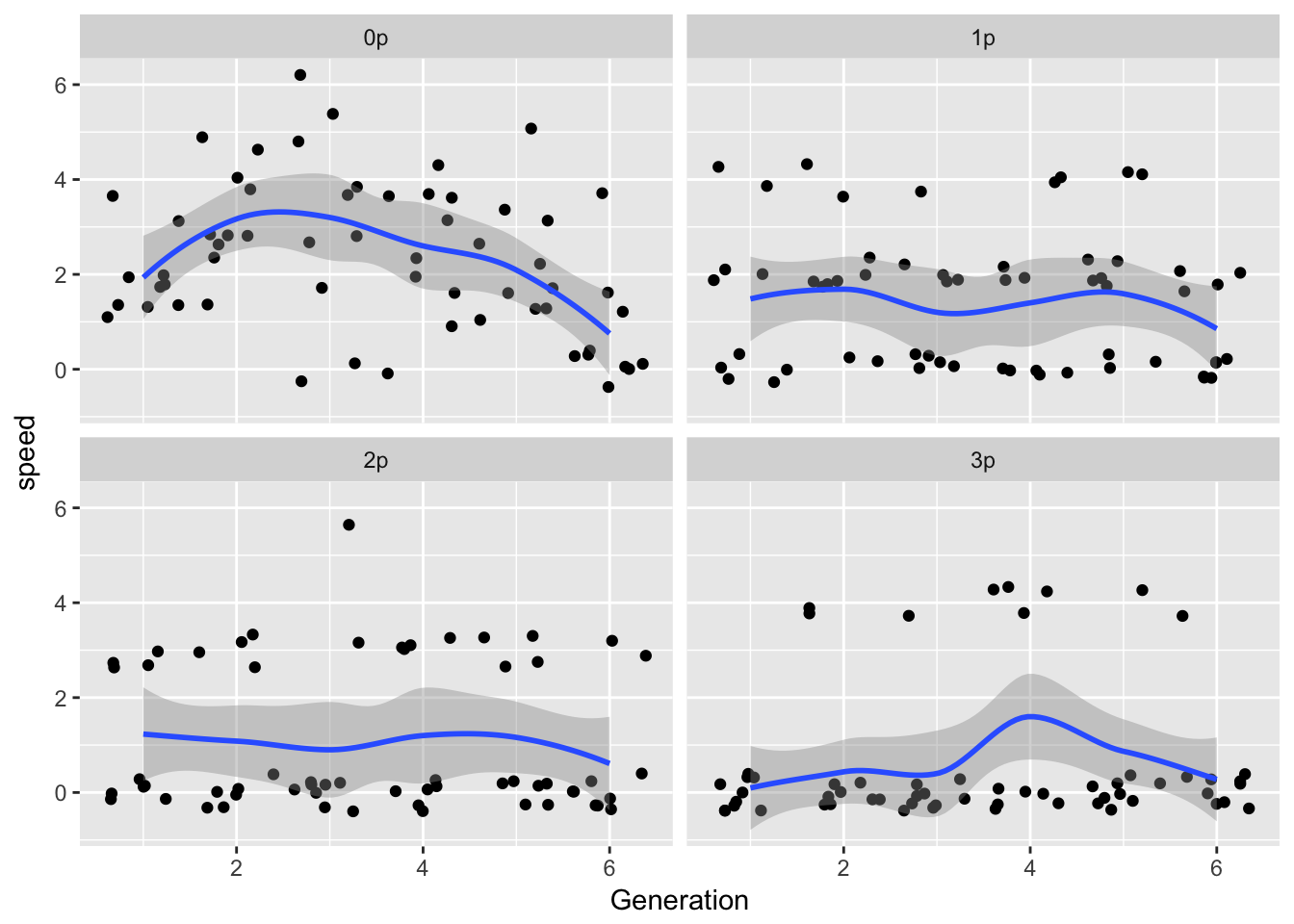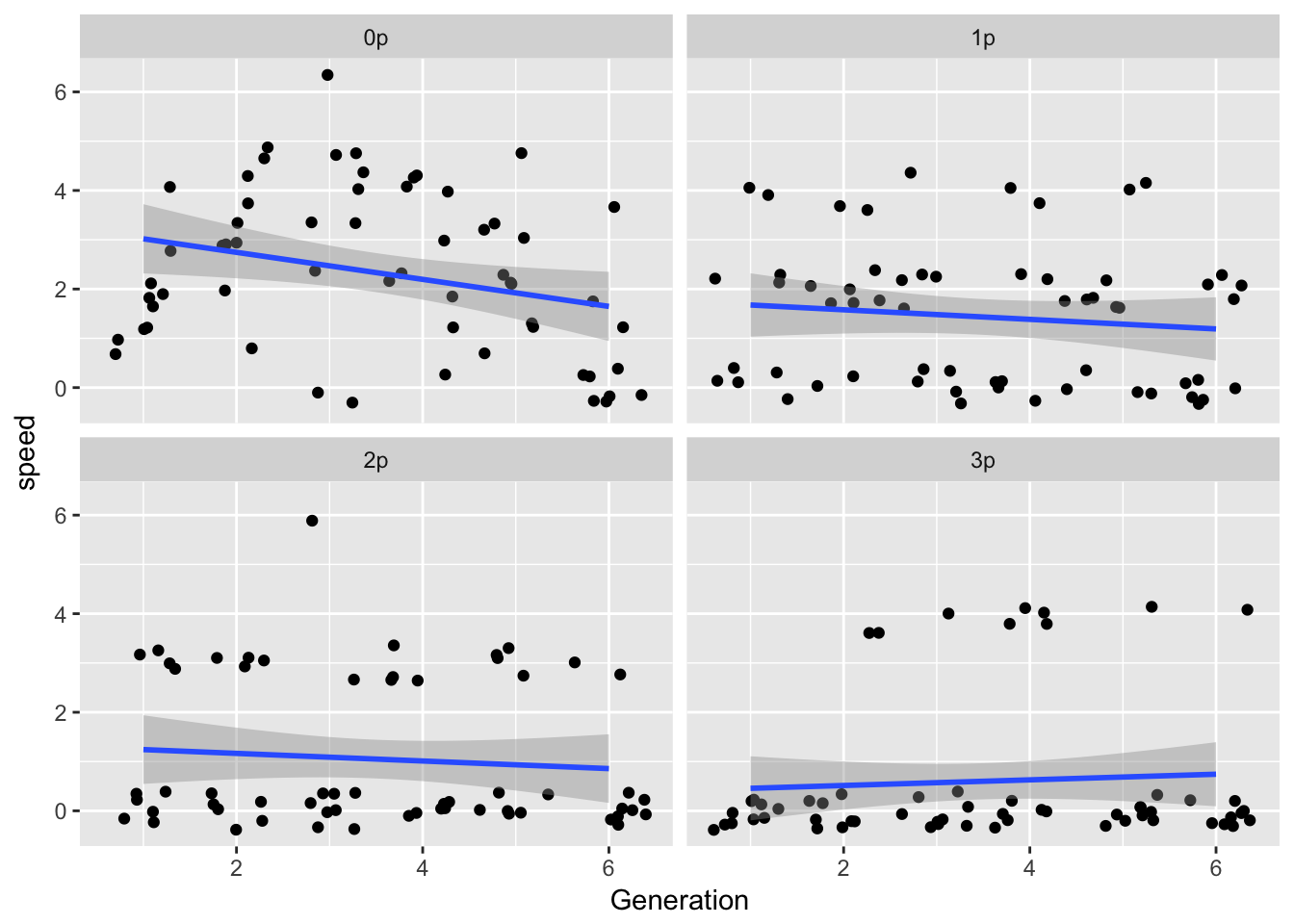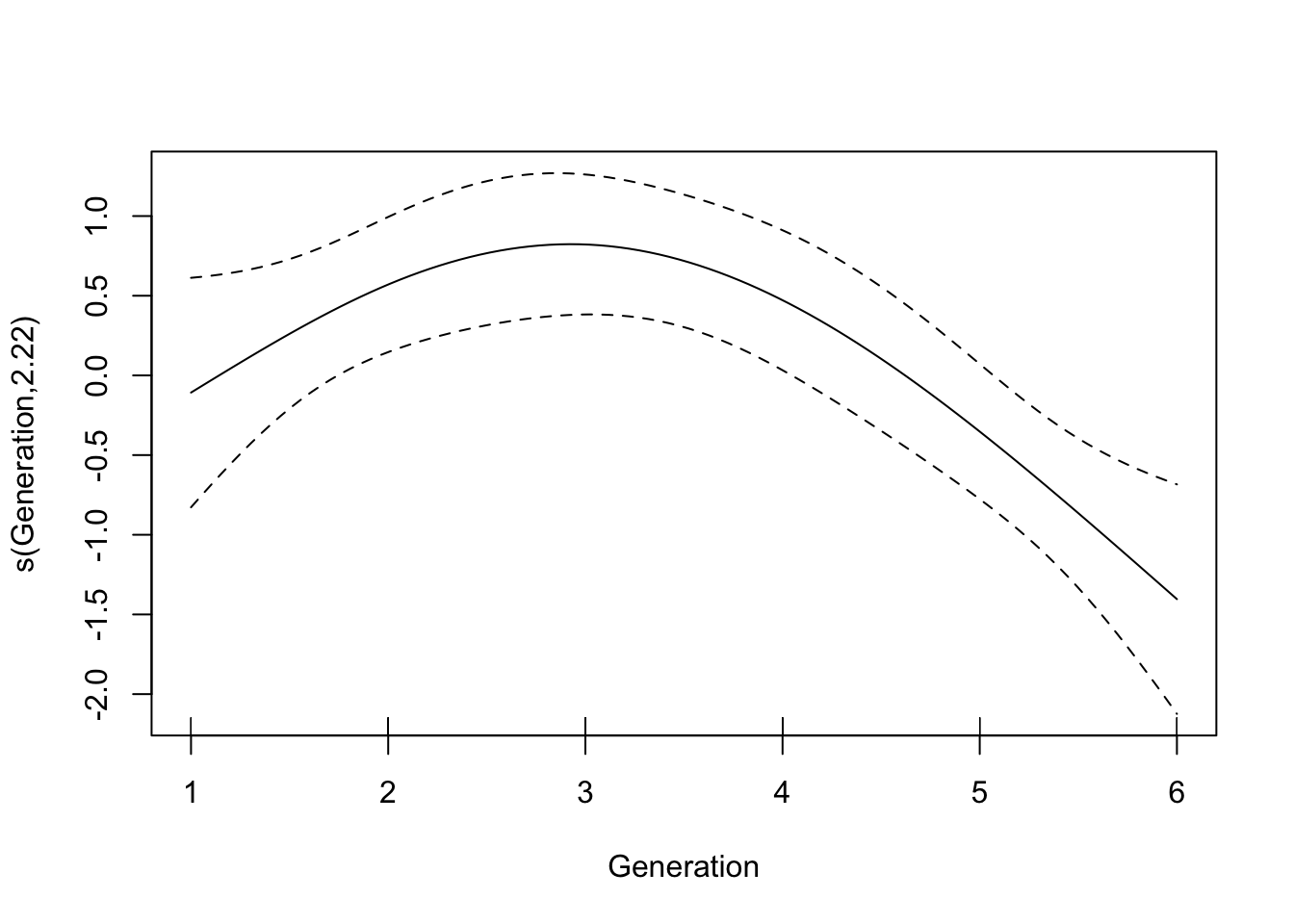10 5 May 2017
10.1 Calculate Ler spread rates
First we look at furthest distance reached.
Ler_furthest_C <- filter(popLer, Treatment == "C") %>%
group_by(Gap, Rep, Generation) %>%
summarise(Furthest = max(Pot))Now calculate per-generation spread rates
# The "default" argument to lag() replaces the leading NA with the specified value
gen_spread <- group_by(Ler_furthest_C, Gap, Rep) %>%
mutate(speed = Furthest - lag(Furthest, default = 0),
speed_m1 = lag(speed))Hmm, there is one case (rep 8, 3p gap) where the forward pot seems to go extinct, resulting in a negative speed. Need to check the original data, but for now let’s just set that to zero.
gen_spread <- within(gen_spread, speed[speed < 0] <- 0)
gen_spread <- within(gen_spread, speed_m1[speed_m1 < 0] <- 0)Look at autocorrelation:
spread_AR <- group_by(gen_spread, Gap, Rep) %>%
summarise(AR1 = cor(speed, speed_m1, use = "complete"))
ggplot(spread_AR, aes(x = AR1)) + geom_histogram(aes(fill = Gap))`stat_bin()` using `bins = 30`. Pick better value with `binwidth`. ALthough it looks like a bias towards negative values, I think that’s mostly from the 3p gaps, where the pattern 0-4-0 will be common.
ALthough it looks like a bias towards negative values, I think that’s mostly from the 3p gaps, where the pattern 0-4-0 will be common.
Look at trends by rep:
ggplot(gen_spread, aes(x = Generation, y = speed, color = as.factor(Rep))) +
geom_point(position = "jitter") +
geom_smooth(method = "lm", se = FALSE) +
facet_wrap(~Gap)
ggplot(gen_spread, aes(x = Generation, y = speed)) +
geom_point(position = "jitter") +
geom_smooth() +
facet_wrap(~Gap)
ggplot(gen_spread, aes(x = Generation, y = speed)) +
geom_point(position = "jitter") +
geom_smooth(method = "gam", method.args = list(k = 4)) +
facet_wrap(~Gap)
summary(lm(speed ~ Generation, data = filter(gen_spread, Gap == "0p")))
Call:
lm(formula = speed ~ Generation, data = filter(gen_spread, Gap ==
"0p"))
Residuals:
Min 1Q Median 3Q Max
-2.4705 -1.3090 0.0295 1.1224 3.5295
Coefficients:
Estimate Std. Error t value Pr(>|t|)
(Intercept) 3.2933 0.4609 7.145 1.67e-09 ***
Generation -0.2743 0.1183 -2.318 0.024 *
---
Signif. codes: 0 '***' 0.001 '**' 0.01 '*' 0.05 '.' 0.1 ' ' 1
Residual standard error: 1.566 on 58 degrees of freedom
Multiple R-squared: 0.08476, Adjusted R-squared: 0.06898
F-statistic: 5.371 on 1 and 58 DF, p-value: 0.02402library(mgcv)
summary(gam(speed ~ s(Generation, k = 4), data = filter(gen_spread, Gap == "0p")))
Family: gaussian
Link function: identity
Formula:
speed ~ s(Generation, k = 4)
Parametric coefficients:
Estimate Std. Error t value Pr(>|t|)
(Intercept) 2.3333 0.1828 12.77 <2e-16 ***
---
Signif. codes: 0 '***' 0.001 '**' 0.01 '*' 0.05 '.' 0.1 ' ' 1
Approximate significance of smooth terms:
edf Ref.df F p-value
s(Generation) 2.223 2.597 7.506 0.000784 ***
---
Signif. codes: 0 '***' 0.001 '**' 0.01 '*' 0.05 '.' 0.1 ' ' 1
R-sq.(adj) = 0.239 Deviance explained = 26.7%
GCV = 2.1184 Scale est. = 2.0046 n = 60plot(gam(speed ~ s(Generation, k = 4), data = filter(gen_spread, Gap == "0p")))
anova(gam(speed ~ s(Generation, k = 4), data = filter(gen_spread, Gap == "0p")),
gam(speed ~ Generation, data = filter(gen_spread, Gap == "0p")),
test = "Chisq") Analysis of Deviance Table
Model 1: speed ~ s(Generation, k = 4)
Model 2: speed ~ Generation
Resid. Df Resid. Dev Df Deviance Pr(>Chi)
1 56.403 113.82
2 58.000 142.17 -1.5975 -28.351 0.0004792 ***
---
Signif. codes: 0 '***' 0.001 '**' 0.01 '*' 0.05 '.' 0.1 ' ' 1So there looks to be some nonstationarity in the continuous runways, with the speed peaking in generation 3. The initial increase makes sense, but the decline does not.